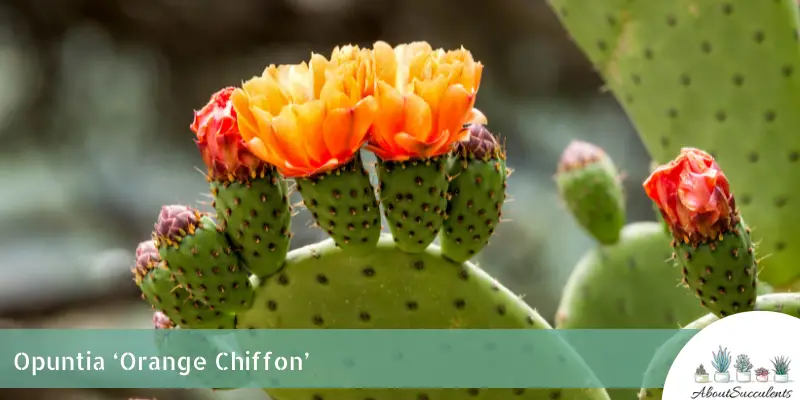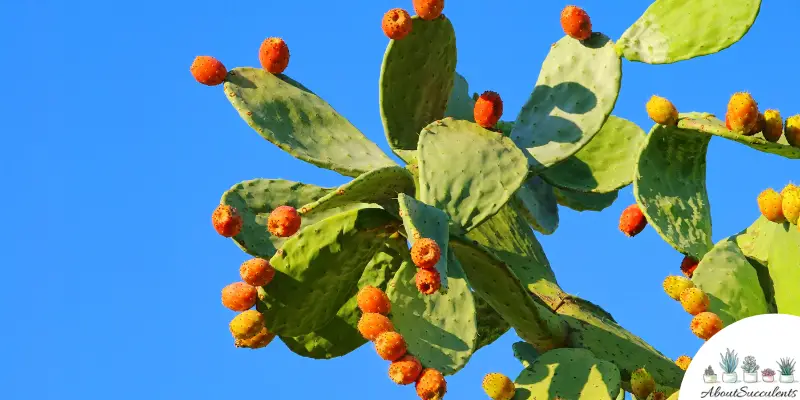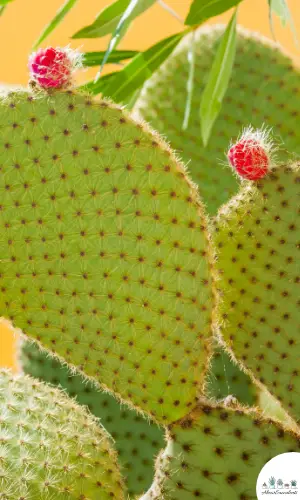
Opuntia “Orange Chiffon” is a low-growing cactus that looks enchanting when in full bloom. In spring, it explodes in clumps of large, sweet orange flowers.
The Opuntia Orange Chiffon has thornless, fleshy, oval, green pads that turn light purple in winter.
This prickly pear cactus variant matures into wide and large shrubs forming a natural fence for an outdoor garden. It grows up to 2-feet (0.60m) and 4-feet (1.22m) wide.
Opuntia Orange Chiffon is native to South America. It is part of the Opuntia genus from the Cactaceae family.
General Information
Also known as: Orange Chiffon
Plant Family: Cactaceae
Origin: Partial to Full Sun
Height: 2-feet (0.60m)
Exposure: Partial to Full Sun; we recommend full sun for the plant to attain maximum colors
Water Needs: Drought tolerant; use the “soak and dry” watering method
Soil Type: Cactus mix or commercially-available succulent soil combined with gritty materials such as sand, perlite, and crushed limestone
Soil pH: 6 to 7.5
How to Grow and Care for Opuntia Orange Chiffon

Opuntia Orange Chiffon is an easy-to-care-for cactus. Although it is best to grow them outdoors to form natural garden barriers, it is possible to grow them indoors in potted containers.
Orange Chiffon is a frost-hardy cactus that can tolerate temperatures as low as -28.8 °C (-20°F).
Sunlight
As an outdoor succulent, plant your Orange Chiffon prickly pears in an area where it can get at least 6 hours of partial to direct sunlight every day. If potted indoors, place it near a South or West-facing window where it can get plenty of filtered light.
Orange Chiffon prickly pears thrive best when exposed to a lot of bright light. When your cactus plant is deprived of sunlight it will suffer from etiolation. This is a condition where the plant loses its natural shape as it stretches out to seek sunlight.
The Orange Chiffon also needs sufficient light exposure for it to bloom well. When your plant starts to lose its vibrant color and shape, move your pot to an area where it can get more sunlight.
Watering

Opuntia Orange Chiffon can survive without water for days. The roots of cacti are prone to root rot so make sure that you water your plant sparingly.
If you live in an area with a rainy season, it is best to grow your cacti in pots. This way, you can move them indoors to protect your plants from heavy rains and damp soil.
Use the ‘soak and dry’ watering technique. Drench the soil with water and then allow it to fully dry out before watering again. Test the soil’s dryness by inserting a stick into the soil. If it comes out dry, water the soil deeply.
During summer, water your Opuntia Orange Chiffon once every seven to 10 days. When the weather starts to become colder, increase your watering intervals because cold temperatures maintain wet conditions longer. Water your plant only when the soil is bone dry during winter.
Pot and Soil
Choosing the right pot for your cactus plant is essential to its survival. The size, shape, and material of your pot will affect the growth and health of your plant.
Cactus plants grow well in terracotta or unglazed ceramic pots because these are made with porous materials that allow good soil aeration. When it comes to size, get one that is 1 to 2 inches (2.54 to 5.08cm) wider than the diameter of your Opuntia Orange Chiffon.
The depth of your pot depends on the length of your plant’s roots. Start with a pot that is 4 to 7 inches (10.16 to 17.78cm) deep. You have to make sure that the roots will have enough space to grow.
Make sure that the pot has a drain hole at the bottom to filter out excess water. If it’s not included, cover the drain hole with a mesh net to keep soil from falling out.
For potting soil, drainage remains the top priority. Use well–draining soil such as cactus mix or a commercially-available succulent brand and combine with gritty materials such as coarse sand, gravel, and perlite.
You do not need to fertilize the soil if your Orange Chiffon is planted outdoors. However, as an indoor succulent, Orange Chiffon won’t be getting the same levels of soil nutrition and fertilization becomes important.
Feed your plant with a low-nitrogen water-soluble fertilizer because the nutrients in container soil get depleted faster. Use a 5-10-10 or 10-10-10 NPK blend (Nitrogen-Potassium-Phosphorus) diluted with water to ¼ strength.
The best time to fertilize the soil is during the growing season which is summer. Lay off the fertilizer during winter when it enters its dormant phase.
How to Propagate Opuntia “Orange Chiffon”
Accentuate the beauty of Opuntia Orange Chiffon by adding more of these charming succulents to your garden. You can multiply your collection of Opuntia ‘Orange Chiffon’ by using stem/pad cuttings.
Stem/Pad Cuttings Method
Step 1: Gently pull one pad from the main plant. Try to separate it as cleanly as you can. You can also use a sterile sharp knife or a pair of pruning shears to cut a stem/pad.
Step 2: Leave the stem cutting in a partially shaded area for 5 days or until the cut end calluses over.
Step 3: Fill a terracotta pot with cactus soil with gritty materials. Insert the stem cutting (calloused end) into the soil.
Step 4: Place the pot in a brightly lit or partially shaded area. Mist the soil when the top 2 inches get dry. After a few weeks, your Opuntia ‘Orange Chiffon’ will begin to root.
Frequently Asked Questions
Is Opuntia “Orange Chiffon” Toxic For Cats And Dogs?
Opuntia Orange Chiffon is not listed as toxic to cats and dogs on the website of the American Society for the Prevention of Cruelty to Animals (ASPCA).
Why Is My Opuntia “Orange Chiffon” Dying?
Opuntia Orange Chiffon is a tough prickly pear but can succumb to early demise due to the following:
Overwatering
Waterlogged soil is the number one cause of cactus death. Overwatering damages the roots due to a lack of oxygen and fungal growth in the soil.
Discoloration on the leaves and stems is a sure sign that Orange Chiffon has been infected. You might notice that parts of the plant have developed yellow-brown spots that are indicative of rotting taking place.
The moment you see discoloration, you must act right away. Get a sharpened and sterilized knife or garden shears and cut off the infected sections or they will spread throughout Orange Chiffon. Remember to wipe off the cutting tool with 70% isopropyl alcohol after each use because it might be contaminated.
Remove the plant from the soil and inspect the roots. Cut off all the roots that have rotted away. Allow Opuntia to dry out while you prepare its new home. Before repotting, you may dip the healthy roots in a fungicide solution to rid of all the fungus.
Clean the old pot thoroughly with a bleach solution or better yet, use a new one. Fill it with fresh cactus mix combined with gritty materials. Repot your cactus and wait for a few days before you water the soil.
Pest Infestation
Opuntia Orange Chiffon attracts cochineal scale, spider mites, and mealybugs. You need to remove these pests immediately before they suck the life out of your plant.
Spider mites are red or yellow-green minuscule pests that survive by drinking the juices from the cactus pads. Since they are not visible to the naked eye, watch out for small webs around your Orange Chiffon.
To remove spider mites, pour 1 part rubbing alcohol diluted with 3 parts water onto the affected area. You can also spray your plant with diluted dish soap (1 tsp dish soap per 1 liter of water).
To remove cochineal scale and mealybugs, spray your plant with water using a high-pressure spray. Use cotton buds dipped in alcohol to remove leftover scales and mealybugs. After removing the pests, spray your Opuntia ‘Orange Chiffon’ with pesticide.
If the pests have reached the roots, wash the roots with warm water, dipped the roots in pesticide, and repot your plant. Make sure to quarantine your pest-infested plants before treatment. This will prevent your healthy plants from getting infected.
If you use alcohol to treat your plants, place the pots in a shaded area for 3-5 days after treatment. Alcohol and sunlight can cause sunburn. If you will repot your plant, disinfect the old pot to prevent reinfection.
Yes, Opuntia ‘Orange Chiffon’ blooms masses of large pastel orange blossoms in spring.
Last Updated on June 9, 2022 by Sofia Lara